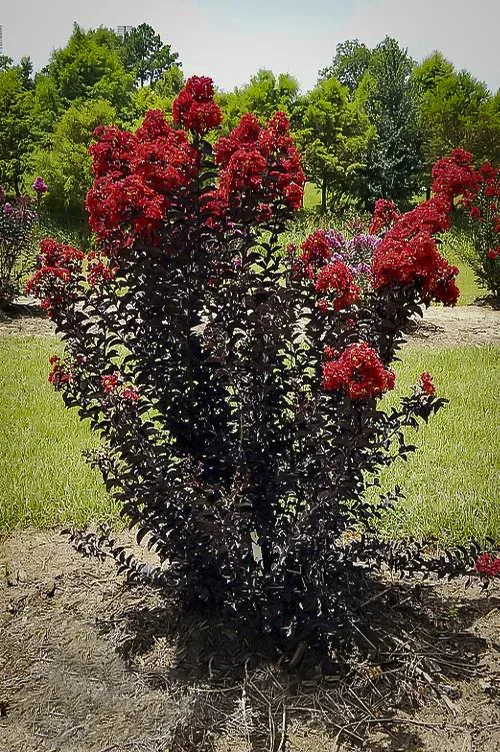If you live in the South, I bet you came across these trees loaded with blooms, shading the streets, all over the place. We cannot but love these easy peasy trees that give us so much for so little care and maintenance.
Crape myrtles are a popular choice for southern gardens due to their vibrant blooms, heat tolerance, and drought resistance. They are known as the "showiest trees of summer"
Here are some of the reasons why crape myrtles are a great fit for southern gardens:
Long blooming season: Crape myrtles typically bloom from early summer to early fall, providing months of colorful flowers.
Variety of colors: Crape myrtles come in a wide range of colors, including red, pink, purple, white, and lavender.
Heat and drought tolerance: Crape myrtles thrive in the hot and humid summers of the South. They are also relatively drought-tolerant, once established.
Low maintenance: Crape myrtles require minimal care, making them a great choice for busy gardeners.
Adaptable sizes: Crape myrtles come in a variety of sizes, from dwarf varieties that grow to only a few feet tall to large trees that can reach up to 30 feet tall. This makes them suitable for a variety of landscaping needs.
Here are some popular crape myrtle varieties for southern gardens:

Muskogee
This variety is known for its long blooming season and lavender-pink flowers. This variety can grow up to 30 feet tall.
Drought tolerant and easy maintenance plant.
will be great to line up the driveway and keep it cool with the shade or as a specimen plant in the back yard

Natchez
This is a popular variety that is known for its large, white flowers. It can grow up to 20 feet tall but can be grown as a shrub also. It looks great lining up the streets. One of the most beautiful aspects of this variety is its peeling back

Catawba
This variety is another popular choice for southern gardens. It has rosy-pink flowers and can grow up to 20 feet tall.
Handsome foliage has bronze hue in spring, is bright green in summer, and turns vibrant orange-red in autumn, creating multi-season interest. Mildew resistant. Develops a nicely shaped naturally rounded dome as it matures. Deciduous.

Bourbon Street: This dwarf variety is known for its clusters of flowers. It typically grows to only 8-10 feet tall. It is cute and low to the ground so you can almost grow it like a bush. You can also try growing it in a hanging basket
Black diamond crape myrtles
This new cultivar was introduced in 2012 and provides a great contrast in the garden with its almost black leaves. It grows fast, stays under 12 feet and blooms from early summer to fall. It may have the same powdery mildew problem that other crape myrtles have
Garden design with crape myrtles
When choosing a crape myrtle for your southern garden, consider the size of the mature tree, the color of the flowers, and the amount of sunlight the tree will receive. With so many varieties to choose from, you are sure to find a crape myrtle that is perfect for your garden.
Crape myrtles are generally low-maintenance trees, but they can still suffer from some common problems. Here are some of the most common problems crape myrtle trees face, along with solutions for how to keep your crape myrtles healthy:
Powdery Mildew

Cause: This is a fungal disease that causes white or gray powdery mildew to form on the leaves, flowers, and new shoots of the crape myrtle. It is most common in shady, humid locations with poor air circulation.
Solution: The most effective way to prevent powdery mildew is to plant your crape myrtle in full sun and space it properly to allow for good air circulation. You can also remove any infected leaves or branches and apply a fungicide.

Crape Myrtle Bark Scale
Cause: These are small, sap-sucking insects that attach themselves to the bark of the crape myrtle. They can cause the leaves to turn yellow and drop prematurely.
Solution: You can control crape myrtle bark scale by using horticultural oil or insecticidal soap.

Japanese Beetles
Cause: These are shiny, metallic green beetles that feed on the leaves of crape myrtles. They can skeletonize the leaves, leaving them brown and unsightly.
Solution: There are a number of ways to control Japanese beetles, including hand-picking them off the tree, using insecticidal soap, or applying nematodes.
Improper Pruning
Cause: Crape myrtles are often pruned incorrectly, which can lead to a number of problems, including stunted growth, poor flowering, and an increased risk of disease. The most common mistake is to prune crape myrtles too early in the spring. Crape myrtles should be pruned in late winter or early spring, before new growth begins.
Solution: If you are unsure of how to properly prune your crape myrtle, it is best to consult with a professional arborist.
Here are some articles about the so called crape murder pruning of crape myrtles -
By following these tips, you can help to keep your crape myrtles healthy and looking their best.
Here are some resources to dig deeper and decide which type will do best in your landscape:
Do you need to revamp your garden or create a brand new garden? please fill out this consultation form and I will be happy to help you.
.png)











Comments